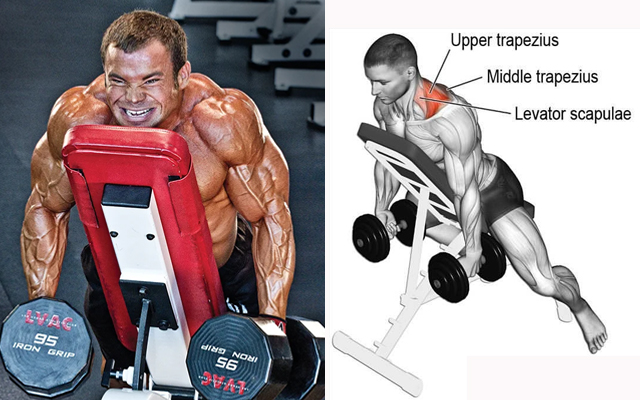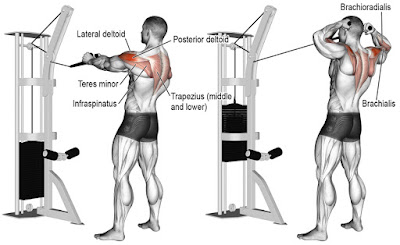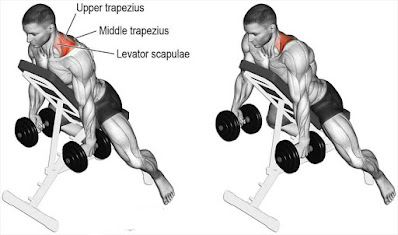You would need to become a trap king in order to create a larger, stronger back.
Well-developed traps may be the key to a well-built and awe-inspiring back (i.e. the trapezius or trapezoidal muscles). The long triangle-shaped muscle in the upper portion of your back takes up a lot of space, so generating it can drastically alter the geography of your upper body.
You can increase the size of your back and shoulders by increasing your stamina in practically all upper body lifts - traps are the secret to scapular and spinal movement, thus everything from shrugging to supporting arms originates from the muscle.
With these 16 cool trap exercises, get started now.
Farmer's Walk
Heavy traps are among the best bang-for-your-buck workouts, so it should come as no surprise that some gym-loaded spins might benefit from them. Flexing kills your back and core gains, so make sure you maintain your shoulders and back engaged all the time.
DO IT: In each hand, keep weight on your hips (dumbbells or kettlebells would do). Maintain a strong and erect posture by engaging your heart and back. For a specific time or distance, take measured, estimated, weight control, and posture measurements.
Face Pulls
Take on the action with this undervalued pass. The face pull can be done with a cable machine or even a resistance band if you concentrate on developing the shape to help protect your back and shoulders. "When done correctly, facial traction impacts the lower traps, which is super-critical and helps in maintaining health," explains fitness director Ebenezer Samuel, C.S.C.S.
DO IT: Set the cable machine or resistance band to an approximate height at eye level. Grab the rope handles or the sling ends in each hand with a sneaky grasp. Pinch your shoulder blades, keep your elbows up, and resist the urge to slump forward to draw closer to your chest. Pull back as far as you can, pause to compress, and then return the cable/bands to their original position.
Bent Over Row
The Y lean is a short stride that may be done as a weightless warm-up, or you can use light dumbbells to train the lower traps. Keep your weight low, though; you might be surprised at how difficult the Y is.
DO IT: Hold the light dumbbells with your thumbs facing up and stand with your feet shoulder-width apart. Zipper on the waist to assume a bending position. Raise your arms in front of you to form the letter Y, and hold the stance for a beat. Slowly return to your starting point.
Pull Up Shrug
This phase will not only help you build your traps but will also help you improve your pull-up form. Because you're not going to isolate just one muscle, you'll also be working the lats.
DO IT: Hang from the pull-out bar, keeping the spine aligned and secure in the center. Draw your shoulders back and down to stretch your head and neck upward. Keep going for a count, then return to the beginning.
Barbell Shrug
The barbell shrug is the king of all trap creation exercises, according to Tyler English, editor of the Men's Health Natural Bodybuilding Bible.
He focuses on the top of the traps, which are responsible for lifting the shoulder blades.
DO IT: Take an overhand grip on a barbell that's just beyond the breadth of your shoulder and hang it the length of an arm in front of your waist. Lean forward about 10 degrees towards your hip, keeping your back naturally arched.
Bend your knees slightly. Now, as high as you can, shrug your shoulders towards your ears. The motion should come to a halt, then resume. Straight arms are required.
Pull the rack
For the rack pull, you will not only have to deal with traps, but also with strength and shape for other compound lifts. You will concentrate more on traction without the full range of motion and lumbar tension of a traditional deadlift by taking the weight off the ground.
DO IT: Set up a rack or box so you can lift the barbell over your shins. In an excessive grip, grab the bar about shoulder width. Zipper at the waist and drive back across the floor with your hips and feet, pulling up the bar and holding your back straight. Pause for a count-up, then check back into position for the weight.
Dumbbell Shrug
In contrast to the barbell shrug, the tension on the shoulder joints is minimized by the dumbbell shrug.
This is because, to keep the bar, the shoulders don't have to move. When you execute the movement, this makes them more stable.
DO IT: Take a pair of dumbbells and allow them to hang close to your hips on one arm, palms facing each other. As big as you can, shrug your shoulders.
Imagine, without moving other parts of your body, attempting to touch your shoulders with your ears. Pause in the high spot, then at the beginning, reduce the weights slowly.
Incline Dumbbell Shrug
The Englishman said that positioning your body on a low-tilt bench helps hit the traps that are most frequently missed.
The lower trapezius is frequently overlooked, leaving the muscle weak, which is responsible for pushing the shoulder blades down. This can contribute to bad posture and make you more likely to sustain injuries such as impingement of the shoulder.
DO IT: Grab a pair of dumbbells and lie on a 45-degree incline bench down to your chest.
Let your arms stand, palms facing each other, straight down. Shrug your shoulders straight up now as you draw together your shoulder blades. Pause, reverse the step, then.
In the traps and calves, the Englishman said, the dumbbell shoulder jump affects the fast-twitch muscle fibers - those with the greatest capacity for size and strength.
Explosive motion gives vitality to the training program. Your aim should be to perform each rep as quickly as possible, while at all times maintaining weight control.
DO IT: Grab and bend your hips and knees with a pair of dumbbells. Let the weights appear just below your knees on your arm, with the palms facing your hips. Do not round the back below.
Simultaneously push your hips, squeeze your shoulders hard and run as high as you can. Land, and reset as smoothly as possible.
Barbell Behind the Back Shrug
The upper traps, intermediate traps, the levator shoulder blades are hit by this action - the rope-like muscle that runs down the back of the neck, the Englishman said.
Don't stick your head forward or down while doing this movement. This can raise the risk of injury and avoid the complete activation of traps.
DO IT: This workout is the same as a barbell lift, except that the weight behind your body is retained.
With too much grip, grab the bar so your palms are facing you and your hands are separated by shoulder width.
Let the bar keep your glutes within easy reach, and then squeeze your shoulders as high as you can into your ears. Pause, reverse the step, then.
Barbell Row
The middle and lower traps and rhomboids are targeted by rowing exercises, the muscles that help keep the shoulder blades going when you raise a weight.
This is important because, in chest and arm exercises, weak shoulders will restrict your strength. Often contributing to the rowing motion are the upper traps, posterior deltoids, and rotator cuff muscles.
DO IT: Hold the bar and keep it within reach with a hand grip that is just beyond the width of the shoulder. Bend and lower your body to your hips and knees, until it is almost parallel to the floor. Keep your back arching naturally.
Squeeze your shoulder blades into each other and lower the bar towards your upper abs. Pause, then lower the bar back to the starting point slowly.
Dumbbell Lateral Raise
During this movement, the central deltoid might be the toughest muscle, but the upper traps also work. They assist in weight gain and act as stabilizers.
In the elevated position, do not rotate the upper arms inwards. (Picture pouring a beer pitcher.) It can lead to conflict with the shoulder. Hold the palms facing forward and up and down with the weights.
DO IT: Take a pair of dumbbells and leave them hanging close to your hips on a single arm. Stand up straight, shoulder-width apart from your feet.
Turn your arms so that the palms face forward and slightly bend your elbows.
Raise your arms towards your shoulders until they are at shoulder height without adjusting the curve of your elbows. With your body, your arms need to form a T. Pause at the height of the movement for 1 second, then slowly decrease the weight to the starting point.
Shrug Overhead Barbell
You work the upper traps by holding the weight above your head while you shrug. It also decreases the focus on the shoulder blade of your levator, the string-like muscle that runs down the back of your neck and, compared to upper traps, is frequently overused.
Since these muscles are often out of alignment, it can contribute to better posture by adding the head barbell scroll to your routine.
DO IT: Carry a barbell with an underarm grip that is about twice the width of your shoulder above your head. The arms should be absolutely straight and shoulder-wide apart from the shoulders of the feet.
Lock your elbows, and that way, keep them. Shrug, attempting to raise the tops of your shoulders as close as possible to your face.
Stop, then send the motion back to its starting location.
Pull With Snell-Grip Handle
Miss the line upright when you hit the traps, and do the high shot instead. When performing the vertical chain, about two thirds of males are at high risk of shoulder impingement.
This is a painful condition where the muscles or tendons of the rotator cuff become stuck in the shoulder joint. It happens most of the time when the arms are at shoulder height or high simultaneously and turned inward - the same place they are in at the top of the vertical row - with a heavy load.
Movement relies primarily on the weight shifting delts, with traps as a secondary emphasis, clarified the English.
However, the high pull is a quick movement of strength that depends on traps, middle back, rhomboids, delts, hamstrings, glutes, and lower back to transfer weight, English says.
The high traction gives the movement a lot more strength and lower body muscle, while the vertical row is a sluggish one," she said, "grindstone" The grip - a wide grip about twice the width of the shoulder - puts less demand on the delts and more demand on the traps than a tighter hand position," said the Brit. So why not use a regular socket?
DO IT: With a light weight, load the bar. Grab the bar with a large handle and leave it in front of your body hanging on one shoulder. You should have your hands within inches of the weight plates. Bend your knees and hips to squat. Your back ought to be arched naturally.
Pull the bar as high as possible by explosively rising to your feet as you bend your knees and lift your upper arms. You're expected to get up on tiptoe. To return to the starting point, reverse the step.
Handlebar overhead Carry
To prevent the weights from moving while you move, to manage the load in the head, the entire trapezius muscle must be enabled, the Englishman said.
The upper body carries out an isometric suspension even when the lower body is in motion. This implies that the duration of the trap under stress is increased, stimulating muscle development.
DO IT: Take a pair of dumbbells and drive them, palms facing each other, over your head. Near to the ears should be the upper arms. Forward walk.
Scaption
Although the anterior delts, rotator cuff, and serratus anterior are mainly affected by this step, traps and lower rhomboids also help lift weight.
This helps to balance the muscles which rotate the blades of the shoulder. It will help develop stronger, healthier shoulders and better posture to add this movement to your upper body routine, says the Englishman.
DO IT: Stand with your shoulder-width feet apart, hold a pair of dumbbells near your hips within easy reach. The palms of the hands should be slightly bent facing each other and the elbows. Stand as straight as you're willing to.
Raise your arms at a 30 degree angle to your body (so they form a Y) until they are shoulder height without adjusting the curve in your elbows. Both hands should face up on the sides of the thumb.
Pause, then lower the weights slowly back to the starting point.

















0 Comments